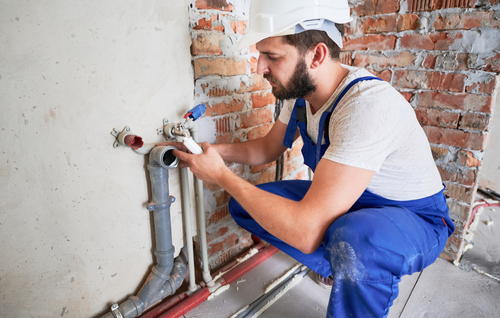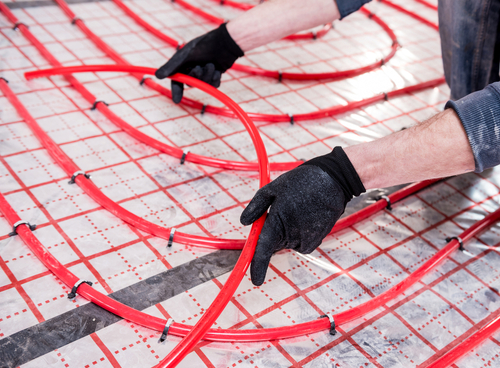Are you looking for information on how to become a pipefitter? Check out our new guide! We’ll walk you through what kind of education is required, the job training available and the career path ahead!
How to Become a Pipefitter
-
Learn more about plumbing degree at NEIT!
Loading…
/**/
To begin, let’s take a look at what pipefitters actually do. These individuals, also known as steamfitters, or simply “fitters,” install and fix piping for heating and cooling systems.
These tradespeople may also be tasked with organizing, assembling, and maintaining pipes that carry chemicals, acids, and gases across manufacturing, commercial, and industrial industries.
START YOUR PROFESSIONAL BUILDING TRADES CAREER
Earn your degree in Professional Building Trades from NEIT and begin your new career path today!
ASSOCIATE'S DEGREE
What is a Pipefitter?

Though often associated with plumbing, pipefitters tend to work more in welding than water or water sanitation. This skillset will help a pipefitter manipulate metal and prepare equipment for installation.
The welding process may also include threading, grinding, cutting, rigging, brazing, soldering, and bending.
Typically, a pipefitter will spend his or her day reading blueprints and installing pipe systems using torches and special tools to tailor the pipes to meet certain specifications.
Necessary Skills for Pipefitters
The Bureau of Labor Statistics has provided some important qualities that all aspiring pipefitters should possess. They include:
Communication: Pipefitters must learn how to communicate important details of the job to clients using layman’s terms. They should be able to communicate what is happening, and why. They should also be able to direct workers, enforce schedule management, and bid on jobs.
Dexterity: A pipefitter must be able to handle tools and parts with precision, even when working in tight spaces.
Mechanical Knowledge: Pipefitters must be familiar with the tools needed to assemble, maintain, and repair pipe systems.
Physical Strength:. Pipefitters must be able to lift heavy tools and materials.
Troubleshooting Skills: A pipefitter must be able to find diagnose, and repair problems. They should also be comfortable setting up and testing new piping systems.
What Kind of Education do You Need to Become a Pipefitter?
A high school diploma or equivalent is typically required of plumbers, pipefitters, or steamfitters. Some may attend a vocational-technical school before pursuing on-the-job training.
Post-secondary education training programs are also available. A training program may take around one year to complete and are typically offered at technical schools or a community college. Curriculums revolve around blueprint reading, math, and welding. Hands-on piping work is also included.
Aspiring pipefitters can also look into degree programs. Pipe fitting instructions are often incorporated into plumbing degree programs, in particular. Those who wish to learn more formal instruction regarding pipefitting might want to think about earning a degree in this area. This decision will land you an Associate Degree in Science or an Associate Degree in Applied Science. A diploma will take around two years to receive.
Of course, the most important step in becoming a pipefitter revolves around the apprenticeship training program.
Apprenticeship training programs are designed to introduce individuals to safety codes and regulations as well as blueprint reading. Pipefitter apprentices will also study mathematics, applied physics, and chemistry. Apprenticeships are sponsored by unions, trade associations, and businesses. Most individuals will enter into an apprenticeship program directly, but some may start out as helpers.
Aspiring apprentices can find more information related to the program through the United Association of Journeymen and Apprentices of the Plumbing and Pipe Fitting Industry of the United States.
Pipefitter Licenses, Certifications, and Registrations
Most states require a license to practice as plumbers, pipefitters, and steamfitters. Also known as a Journeyman Pipefitter, a licensed individual will need anywhere from 2 to 5 years of experience under their belts as well as the ability to pass an exam on trade and local codes. This test must be completed before pipefitters will be permitted to work independently.
Pipefitter Salary, Employment, and Job Conditions

The Bureau of Labor Statistics predicts that employment among plumbers, pipefitters, and steamfitters will grow by 14 percent between 2018 and 2028. That’s a much faster rate than other professions are slated to experience.
According to the bureau, pipefitters can earn a salary of over $55,000 per year, or just over $26.50 an hour. The more work experience a fitter gains, the more they can expect to be paid.
A journeyman pipefitter or steamfitter could easily find work in industrial settings, specifically at a power plant, construction site, factory, or office building. Salary increases can be attained by union journeymen through negotiated contracts with management.
Pipefitters may be required to work outside in harsh temperatures. They often spend long periods standing and working in tight quarters. It is common for pipefitters to work up to 12 hours at a time. They may also receive emergency service calls during their off-hours.
Injuries may be sustained on the job and include ladder falls, cuts from sharp tools, and burns from steam pipes.
Opportunities at the New England Institute of Technology.
Want to become a professional pipefitter? Our associate degree program in plumbing and heating technology can put you on the right path! The program is broken up into two distinct areas of study: heating in residential structures and plumbing in residential, commercial, and industrial structures.
START YOUR PROFESSIONAL BUILDING TRADES CAREER
Earn your degree in Professional Building Trades from NEIT and begin your new career path today!
ASSOCIATE'S DEGREE
The four-term plumbing portion of the program includes the study of basic tools, methods of fabrication, fitting identification and usage, drainage, waste and venting, water piping methods and design, sewage disposal and treatment, water sources and distribution, and household and industrial maintenance.
The heating portion is distributed over two terms and covers various heating systems such as steam, warm air, and forced hot water. Classes will also focus on burners used in conjunction with these systems and their associated control circuitry.
Students will learn about the installation of heating systems, gas technology, solar heating abilities, and an introduction to welding. Electrical wiring, heat loss calculations, and system design as they relate to residential and commercial applications will also be included.
The program also includes a theory and lab experience. This portion will cover the design, installation, troubleshooting, and servicing of a vast array of heating units.
Find out more about our program here. You can also fill out this form for more information on how NEIT can help you achieve your goals.

